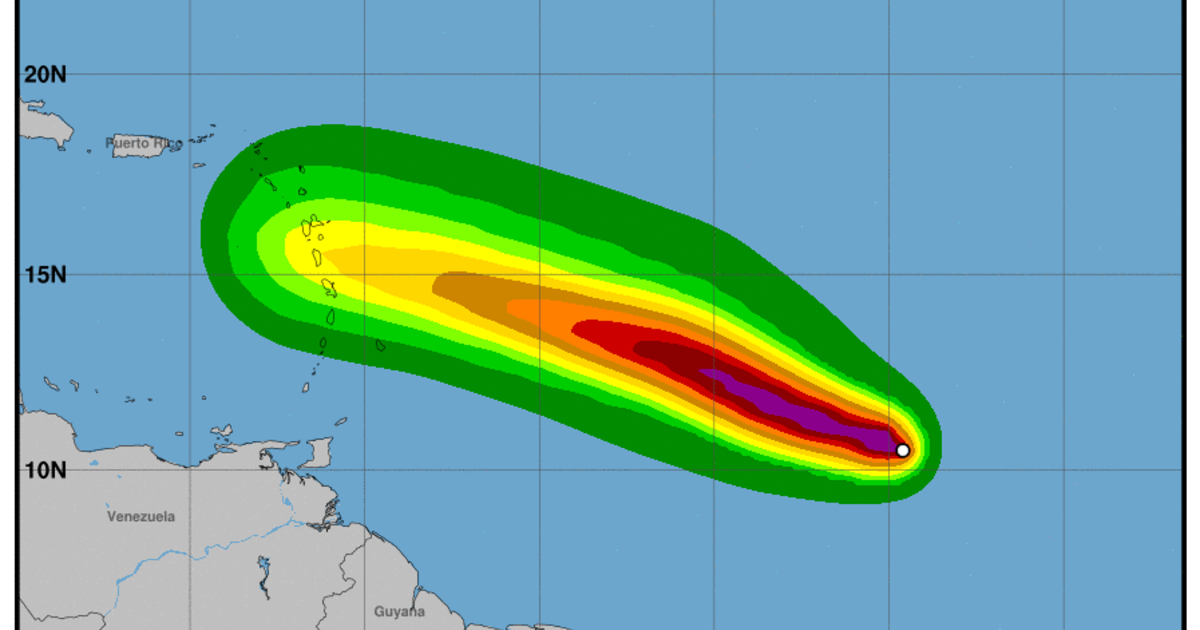Projected Path Forecast

Beryl projected path – Beryl, currently classified as a tropical storm, is projected to continue its westward movement across the Atlantic Ocean. The storm is expected to intensify into a hurricane within the next 24 hours, bringing potential threats to the Caribbean islands and the southeastern United States.
The projected path of Beryl is influenced by several factors, including wind patterns, atmospheric pressure, and ocean currents. The storm is expected to follow a general westward track, steered by the prevailing easterly trade winds. As Beryl moves over warmer waters, it is likely to gain strength and energy, leading to its potential intensification into a hurricane.
Current Location and Direction
As of the latest update, Beryl is located approximately 1,000 miles east of the Lesser Antilles. The storm is moving westward at a speed of 15 miles per hour.
Potential Landfall Areas
Based on the current forecast, Beryl is projected to pass south of the Lesser Antilles and approach the southeastern Bahamas by Tuesday. The storm could potentially make landfall in Florida or the southeastern United States later this week. However, it is important to note that the projected path of the storm is subject to change, and residents in potential impact areas should closely monitor the latest forecasts.
Impact Assessment

Beryl’s projected path poses significant risks to various areas. Coastal communities, inland regions, and vulnerable infrastructure face potential impacts, including flooding, storm surge, high winds, and power outages. Assessing these risks is crucial for implementing safety measures and evacuation plans.
Identifying potential areas at risk involves examining Beryl’s forecasted path, considering factors such as its intensity, speed, and expected landfall location. Coastal communities within the storm’s projected path are particularly vulnerable to storm surge and flooding. Inland regions may experience heavy rainfall, leading to flash floods and riverine flooding.
Coastal Impacts
Coastal communities face the brunt of Beryl’s fury, with storm surge and flooding posing significant threats. Storm surge, a wall of water driven by the storm’s winds, can inundate coastal areas, causing widespread damage to infrastructure, homes, and businesses.
- Storm surge can penetrate far inland, especially in low-lying areas and those with vulnerable coastlines.
- Flooding from storm surge can contaminate drinking water sources, disrupt transportation networks, and lead to power outages.
Inland Impacts, Beryl projected path
Inland regions are not immune to Beryl’s impacts. Heavy rainfall can cause flash floods and riverine flooding, leading to dangerous conditions and infrastructure damage.
- Flash floods occur when intense rainfall overwhelms drainage systems, resulting in rapid and often unexpected flooding.
- Riverine flooding happens when rivers overflow their banks due to excessive rainfall, leading to widespread inundation.
Infrastructure Impacts
Vulnerable infrastructure, such as power lines, communication networks, and transportation systems, is susceptible to damage from Beryl’s high winds and flooding.
- High winds can topple power lines, causing widespread power outages and disrupting essential services.
- Flooding can damage roads, bridges, and railways, hindering transportation and emergency response efforts.
Safety Measures and Evacuation Plans
To mitigate the impacts of Beryl, it is crucial to implement safety measures and evacuation plans for affected areas. Residents in high-risk areas should follow official instructions and evacuate if necessary.
- Stay informed about the latest weather forecasts and warnings.
- Prepare an emergency kit with essential supplies, including food, water, first aid, and medications.
- Identify evacuation routes and shelters in case of an emergency.
- Secure loose objects outdoors and bring pets indoors.
Historical Context: Beryl Projected Path
Throughout history, the region has witnessed the destructive force of tropical storms and hurricanes. Beryl’s projected path bears similarities and differences to past storms, providing valuable insights for response and recovery efforts.
Historical Precedents
- Hurricane Carla (1961): A Category 4 hurricane that made landfall in Texas, bringing devastating winds, storm surge, and flooding.
- Hurricane Ike (2008): A Category 4 hurricane that caused widespread damage in Texas and Louisiana, particularly to coastal infrastructure and homes.
- Tropical Storm Allison (2001): A slow-moving storm that dumped record-breaking rainfall over Texas and Louisiana, leading to severe flooding and property damage.
Comparative Analysis
Beryl’s projected path shares similarities with Hurricane Carla in terms of its intensity and potential for storm surge. However, it is expected to be more similar to Tropical Storm Allison in terms of its slow movement and potential for heavy rainfall.
Lessons Learned
Past storms have taught us the importance of:
- Early evacuation and preparedness
- Reinforcing coastal infrastructure
- Developing comprehensive disaster response plans
These lessons will guide Beryl’s response and recovery efforts, aiming to minimize damage and protect lives.